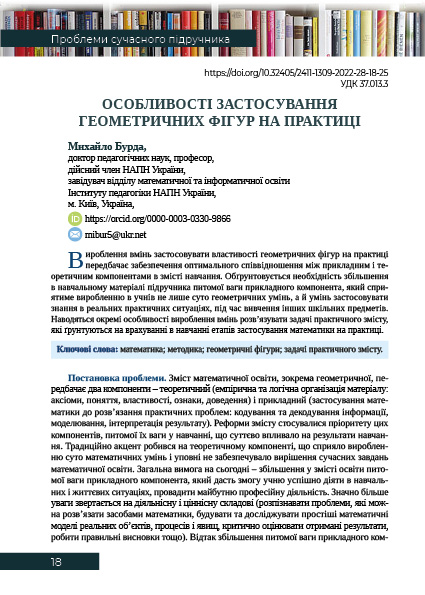
Published 2022-07-20
Keywords
- mathematics,
- methodology,
- geometric shapes,
- applied tasks
How to Cite

This work is licensed under a Creative Commons Attribution-NonCommercial-ShareAlike 4.0 International License.
Abstract
Developing the ability to apply the properties of geometric figures in practice involves the optimal relationship between applied and theoretical components of learning content. The necessity of increasing the value of the applied component in the textbook is substantiated. This component will provide students with not only purely geometric skills, but also the ability to apply knowledge in real practical situations, while studying other school subjects.
The basis of the proposed methodology is to take into account in teaching the content and features of the stages of application of mathematics in practice, i. e. the method should include three interrelated components: organization of empirical generalizations (aimed at “discovering” mathematical fact) based on this – the formulation of the statement); logical organization of educational material (proving or refuting a hypothesis, solving basic problems that allow you to design appropriate methods of activity); application of mathematical fact in practice (in educational and real practical situations, while studying other school subjects). The second and third components of the methodology are recommended not to be removed in the study time, but to be as close as possible and considered as a mutually inverse activity. Some methods of developing the ability to solve problems of practical content, in particular: interpretation in practice of elementary figures, their properties and some ways of functioning; use of pairs of problems: geometric and corresponding practical problem; transition from the method of mathematical activity to problems of practical content; use of signs of equality of auxiliary triangles; focus on practical situations for which this geometric model is most often used.
Downloads
References
- Бурда, М. І. (2020). Зміст підручників з математики у контексті результатів дослідження PISA‑2018. Проблеми сучасного підручника, (24), 14–21. https://doi.org/10.32405/2411-1309-2020-24-14-21.
- Бурда, М. І., Тарасенкова, Н. А., Васильєва, Д. В., & Вашуленко, О. П. (2018). Концепція математичної освіти 12-річної школи. Математика в рідній школі, (7–8), 2–8. https://lib.iitta.gov.ua/711990/1/%D0%9A%D0%BE%D0%BD%D1%86%D0%B5%D0%BF%D1%86%D1%96%D1%8F%20%D0%BC%D0%B0%D1%82%D0%B5%D0%BC%D0%B0%D1%82%D0%B8%D1%87%D0%BD%D0%BE%D1%97%20%D0%BE%D1%81%D0%B2%D1%96%D1%82%D0%B8.pdf.
- Васильєва, Д. В. (2018). Математичні задачі як засіб формування ключових компетентностей учнів. Проблеми сучасного підручника, (21), 83–91. https://doi.org/10.32405/2411-1309-2018-21-83-91.
- Вашуленко, О. П., & Сердюк, Е. Г. (2019). Принципи добору системи вправ до підручника з геометрії для ліцею. Проблеми сучасного підручника, (23), 47–55, https://doi.org/10.32405/2411-1309-2019-23-47.
- Волошена, В. В. (2021). Дидактичні вимоги до компетентнісно-орієнтованих задач в процесі навчання математики. Проблеми сучасного підручника, (27), 36–45. http://ipvid.org.ua/products/2021_2/Statti/5.pdf.
- Насадюк, Т. О. (2017). Особливості використання практико-орієнтованих проектів під час навчання математики учнів 5-го класу. Науковий часопис НПУ імені М. П. Драгоманова, (3) 19, 51–57. https://fmf.npu.edu.ua/images/files/StorinkaVikladacha/Shkolnyi/1819/Chasopys_NPU_seria_3_vol_19.pdf.
- Прус, А., & Швець, В. (2007). Прикладна спрямованість стереометрії. 10–11 кл. Шкільний світ.
- Яковлєва, О. М., & Каплун, В. М. (2019). Аналіз завдань практичного змісту ЗНО з математики 2017–2019 років. Фізико-математична освіта, (4) 22, 142–149. http://repository.sspu.edu.ua/handle/123456789/8514.
